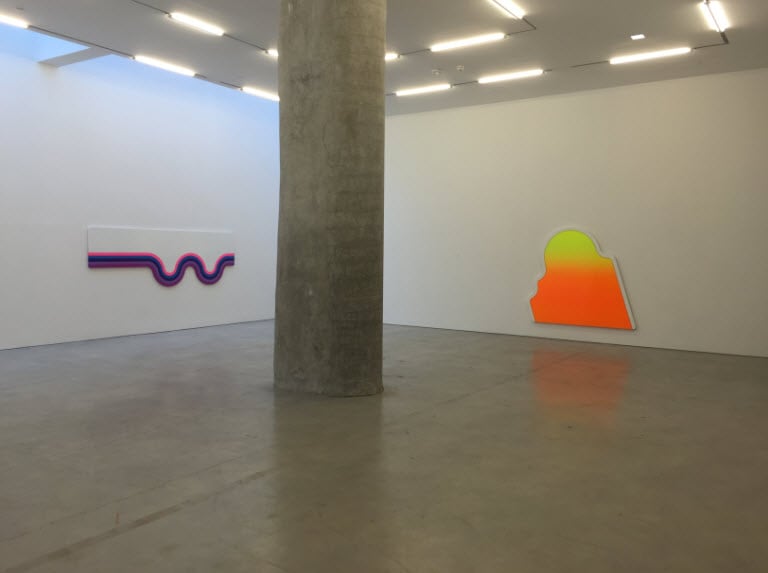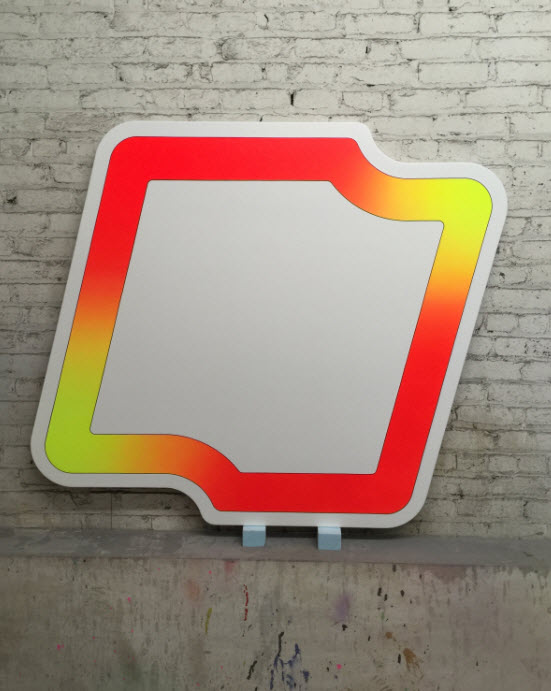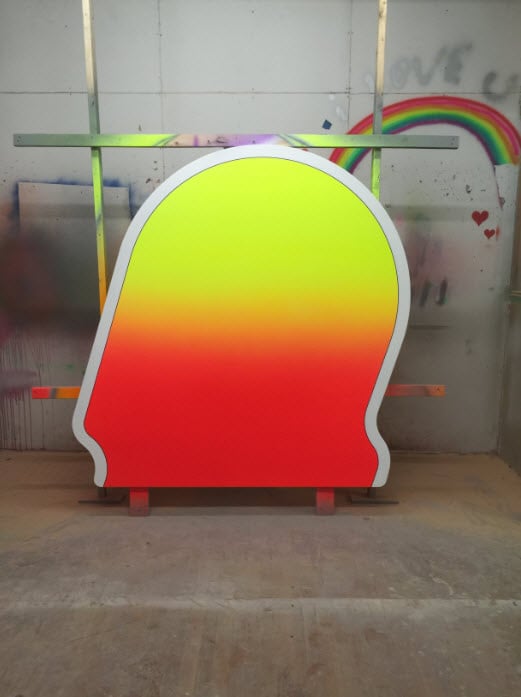Art & Exhibitions
artnet Asks: Abstract Artist Greg Bogin
Bogin is inspired by his stormy childhood and love for long-distance cycling.

Bogin is inspired by his stormy childhood and love for long-distance cycling.

Artnet News


“Sunny Disposition” installation view, Marlborough Chelsea.
Photo: Courtesy of the artist.
The artwork of New York City native Greg Bogin currently fills the expansive first floor of Marlborough Chelsea. The artist’s solo exhibition, entitled “Sunny Disposition,” effectuates feelings of happiness with its contrasting, electric color gradients and playful silhouettes. Although not without underlying irony, this body of work provides temporary relief from the world’s ugliness and everyday woes. Bogin derives inspiration from many aspects of his life, including his stormy childhood and love for long-distance cycling, while continually striving to push his creative boundaries. His show is on view now through the end of July.
When did you know you wanted to be an artist?
As a kid, I took life-drawing classes at the Art Students League in New York, and then attended The High School of Music & Art, now the Fiorello H. LaGuardia High School of Music & Art and Performing Arts. During my first year of high school, art was still more of a hobby for me than a path. In my second year, I saw an exhibition of Leonardo da Vinci drawings at The Metropolitan Museum of Art; as cliché as it sounds, it was a life-altering experience. The following day in drawing class, I realized I was not untalented and began to dedicate myself, and it went on from there.
If you were not an artist, what would you be doing?
I don’t know. I can’t imagine not being an artist; it’s an inseparable part of me and how I experience the world. If I were to do something else it would have to have a lot of creative freedom. I don’t like to follow rules. I think to really be an artist is a risk-everything situation that requires such a big commitment it’s hard to imagine a plan B.
Professionally, what is your goal?
My professional goal is to produce the best work possible and to keep pushing the limits of what I consider to be a painting so that the work is always moving forward and evolving. I have been working for the last several months on my current exhibition at Marlborough Chelsea called “Sunny Disposition,” which is up through the end of July. I strived to make a room of paintings that put the viewer in a good mood. Following that, I have a show coming up in the fall at Galerie Frank Elbaz in Paris. I have shown extensively in Europe, but have not had the opportunity to exhibit before in Paris, so I am very excited to get to work on it.

Greg Bogin, Undisturbed state (2015). Synthetic paint and urethane on canvas, 48 x 55 in.
Photo: Courtesy of the artist.
What personal narratives are related to your work?
I had a turbulent childhood and was a shy kid, which in some ways colored the way I see the world. This created a desire in me to express myself in a way that did not involve words. I became interested in the ability of visual graphic information to communicate many different ideas in a compact way. I found I developed an affinity for the seeming symbols of optimism and joy, so my work gravitates toward bright colors, friendly forms, and large expanses of uncluttered space.
The world is dark enough, so I set out on a path of making work that hopefully makes people feel happy and creates a momentary respite for myself and the viewer.
What does an average day in the studio look like for you?
Well there are really no average days, and it depends on what I am working on at the time. Some days are creatively different than others. If I am in an exploratory phase, I make many drawings and spend a lot of time looking and thinking, so those days it is important to keep my mind open and allow surprises to happen.
When I hit on something that is worth translating to a painting, then the days are different; I’m more involved in the physical act of making than the act of conceiving. That does not mean those days are less creative; they have a more zen-like quality, where repetitive actions lead to the resulting painting.

Greg Bogin, Happy Ending (2015). Synthetic paint and urethane on canvas, 57 x 73 in.
Photo: Courtesy of the artist.
What has been the greatest challenge you have faced so far?
The greatest challenges I have faced are the times when I do not feel inspired and do not want to work. It takes faith, discipline, and self-confidence to keep working through those moments. It can be hard to be alone in the studio waiting for lightning to strike. It means sometimes working when you don’t want to, and not being too hard on yourself if the day does not produce the results you’re looking for. Over time, I have learned that by keeping my eyes and mind open and working through these moments, eventually I arrive at a place where, out of the corner of my eye, something grabs my interest. Part of being an artist is allowing yourself to discover something you were not expecting.
What are your greatest strengths and weaknesses?
I think my greatest strengths are my weaknesses. What I mean is that, often, artistic weakness can lead to the most growth. Édouard Manet for instance wished he could paint like Alexandre Cabanel, but the fact that he could not led him to another path, which fortunately led to Modernism.
Strengths take care of themselves, they are skills you can rely on, but they have the danger of becoming crutches to progress. Embracing weakness artistically can put you in the realm of the unknown, and, by leaving your comfort zone, it forces creative solutions you might not have found had you only stuck to your strengths.
What do you love the most about the art world?
I love the people in the art world; I have made many great and lasting friendships here. I love that there is a community engaged in the impractical pursuit of creative self-expression, which I think is one of humanity’s greatest attributes. The more creativity in the world the better. When I go to an opening and see so many people interested in art, it always makes me happy.

Greg Bogin, Sunny Disposition (there’s always tomorrow) (2015). Synthetic paint and urethane on canvas, 72 x 73 in.
Photo: Courtesy of the artist.
What are your hobbies outside the art world?
My hobby, or rather obsession, outside of the art world is professional bicycle racing. I am an avid long-distance cyclist. The aesthetics of bike culture have been an influence on my work—stripes, logos, and gradients are frequently employed in team uniforms and bicycle paint schemes, which relate directly to my work. There are also great life lessons in cycling, like pushing past personal limits and learning to relax and training when you would rather be home in bed.